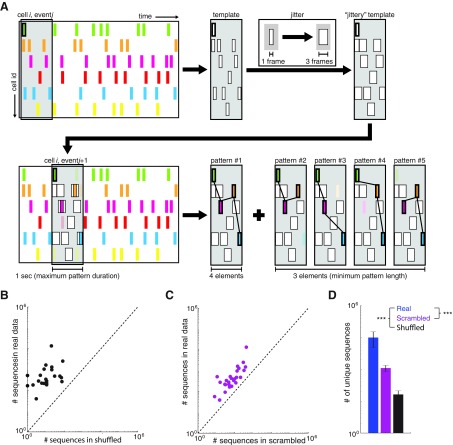Fig. 4.
Prefrontal microcircuits spontaneously generate many more stereotyped sequences of activity than expected by chance. A: schematic outlining the detection of temporal patterns. Briefly, a reference event was chosen, and from that event a template was constructed based on all the active events that occurred during the following 1 s. This template was counted as an existing pattern if it matched a previously generated template (allowing for up to 1 frame of jitter) or as a new pattern otherwise. Each subpattern contained within the original template was similarly compared. This process was repeated iteratively using all events in all cells as the reference event. B: for each data set (n = 29), the number of unique temporal patterns is plotted against the number of patterns in a shuffled version of the same data set. Each data set was shuffled by shifting the activity raster for each neuron over in time by a random amount (different for each neuron). All 29 points lie above the unity line, indicating that actual data sets always contain more unique temporal patterns than expected by chance. C: for each data set (n = 29), the number of unique temporal patterns is plotted against the number of patterns in a “scrambled” version of the same data set. Each scrambled data set was generated from the original data set by randomly reassigning the identity of the cell associated with each epoch of activity. Again, all 29 points lie above the unity line, indicating that actual data sets always contain more unique temporal patterns than expected by chance. D: bar plot summarizing the data plotted in B and C. ***P < 0.001 by Wilcoxon rank sum test.

